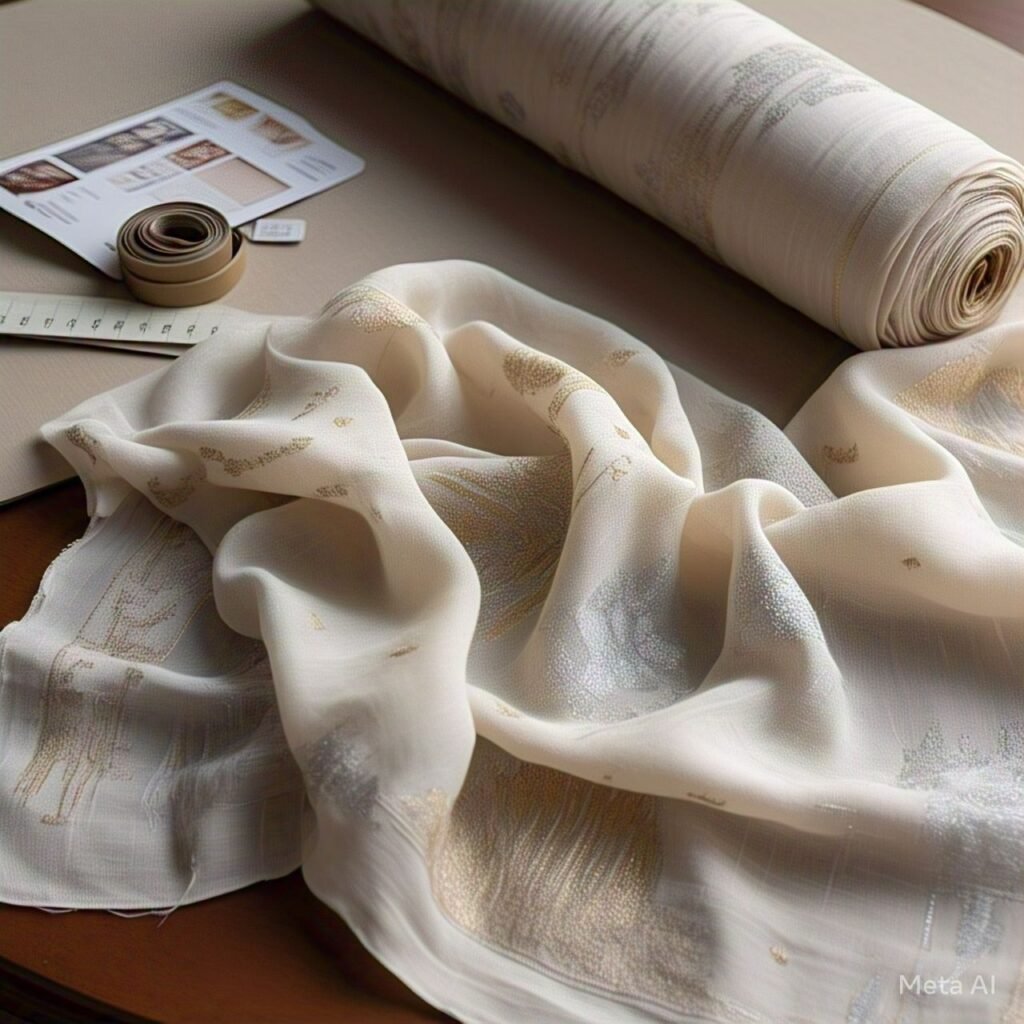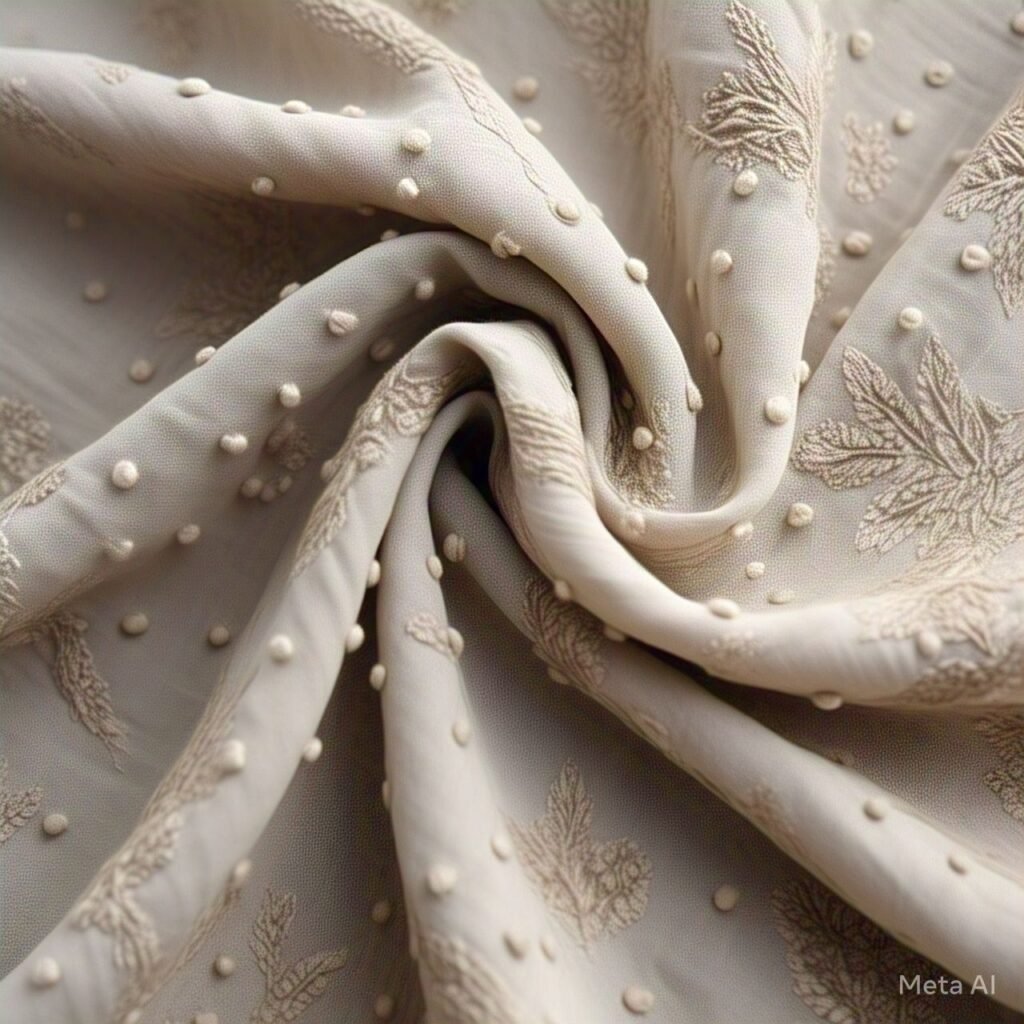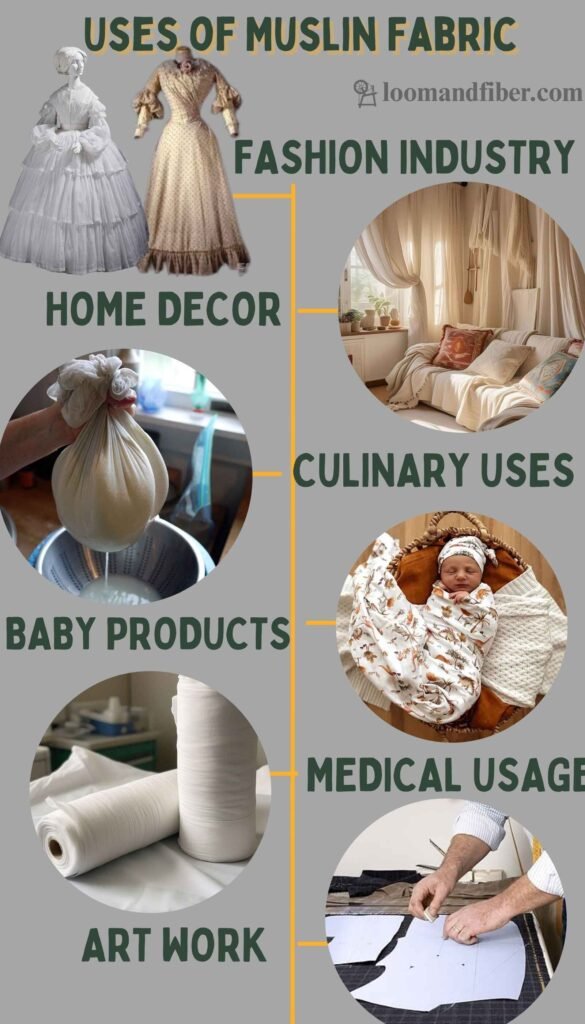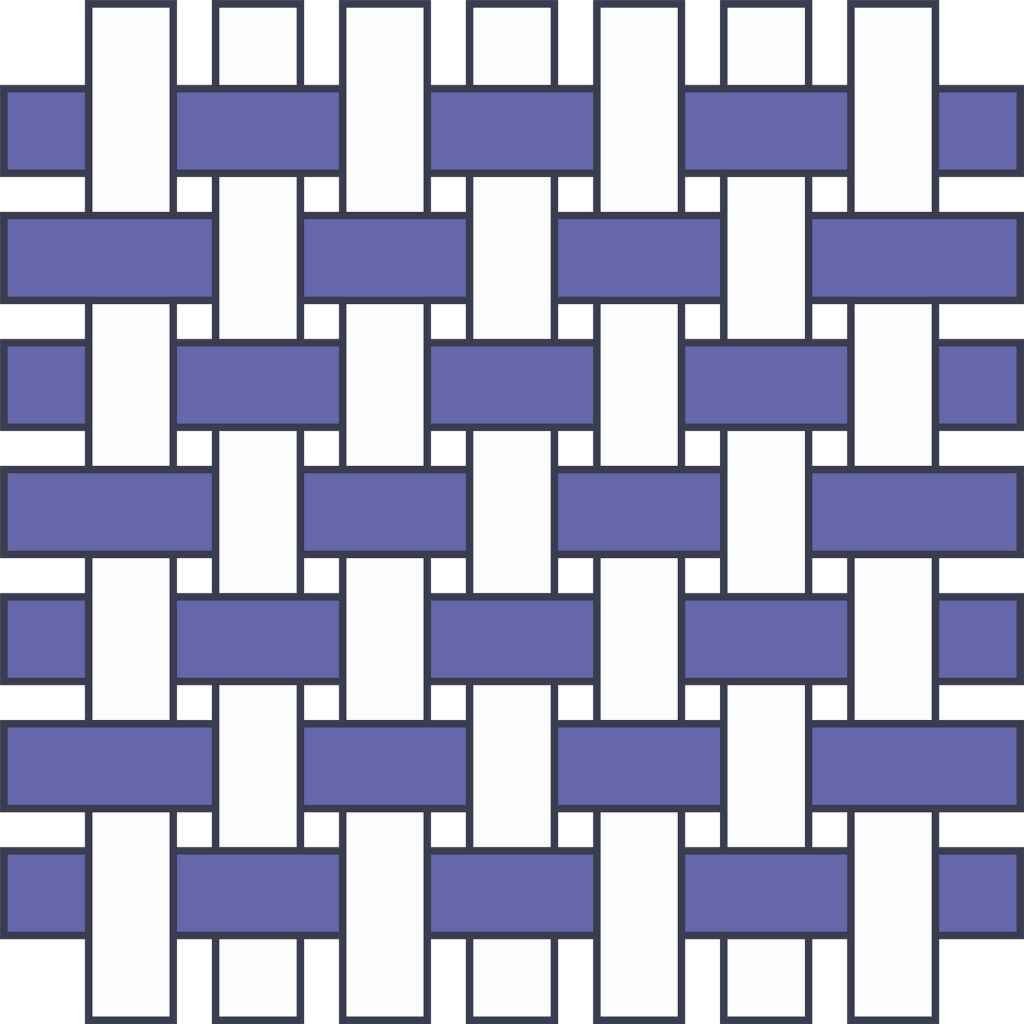Muslin fabric continues to capture the eyes and hearts of many even today. Designers, chefs, and artists alike revere the fabric for its versatility and timelessness; making it highly sought after since ancient times. Muslin fabric plays an important role in various uses such as swaddling infants, creating beautiful dresses, and even preparing gourmet dishes. This makes one wonder what muslin fabric is. And why has it captured the hearts of so many people throughout history?
What is Muslin Fabric?
Muslin fabric is a soft and lightweight woven cotton textile. This fabric first engraved its significance from the regions of the Indian SubContinet and is still used in modern-day global fashion. In the olden days, muslins were regarded as luxury fabrics and were highly esteemed by traders, merchants, and the royals. Muslin is widely used in the modern day not just in fashion and interiors, but also in food and photography.
Thanks to its breathability, strength, and eco-friendliness, muslin remains a preferred fabric for many. But what makes muslin stand apart from other oxfords, sateens, and cambric fabrics?
Complete History of Muslin Fabric
Origins in Ancient Bengal (Before 3rd Century BCE)
Highly skilled artisans initially began weaving Muslin in Dhaka, Bengal, which was famous for the finest quality muslin known as Dhaka Muslin. It was produced from an exceptionally fine variety of cotton plants called Phuti Karpas that was indigenous to the area. It was of such fine quality that it could be described as “woven air,” and it was so lightweight that it was claimed to be able to fit in a small box or pass through a ring.
Muslin in the Roman and Middle Eastern Empires (1st – 10th Century CE)
Bengal merchants were exporting muslin to Rome, Greece, and the Middle East where it was widely prized by the wealthy upper class. This is even mentioned in the works of ancient writers, for instance, the Greek historian Herodotus admired its quality. Arab traders heavily influenced the spread of muslin in Asia and Europe.
The Golden Age of Muslin (16th – 18th Century)
Muslin production peaked between 1526 and 1857 during the Mughal Empire’s reign. The Mughal rulers, especially Emperor Aurangzeb, adored muslin fabric, and it quickly gained popularity among the elite. Because of its lightness and transparency, muslin was poetically referred to as ‘cloud-like’ clothing by many historians and poets of the Mughal Era. Traders from the British East India Company began exporting muslin to Europe which soon transformed into a mark of elegance.
The Decline of Muslin (19th Century)
The conventional production of muslin started to decline with British rule as the British industrialized. The British government placed enormous tariffs on Indian textile artisans and forbade domestic production which compelled the populace to purchase textiles from England. As a result, British colonial policies and industrial competition destroyed the once prosperous muslin industry of Dhaka and nearly wiped out the Phuti Karpas cotton shrub.
Revival of Muslin (20th – 21st Century)
In the past few years, organizations and craftsmen have attempted to revive muslin weaving in India and Bangladesh. Today, artisans and designers are working to restore the lost art of hand-worked Dhaka Muslin using traditional workmanship techniques. Due to its thin, breathable nature, Muslin remains a highly valued fabric in fashion, aristocratic dressing, and shawls, as well as in medical uses.
Characteristics and Properties of Muslin Fabric
Muslin fabric is renowned for its diverse qualities that make it highly desirable. Some additional characteristics include:
- Thermal Regulation: Muslin keeps the body cool in warm weather and provides light warmth in cooler conditions.
- Hypoallergenic: Its natural fibers are gentle on sensitive skin, reducing the risk of irritation or allergies.
- Quick Drying: The fabric dries quickly, making it ideal for baby products and reusable cloth items.
- Eco-conscious Approach: Muslin is compostable and eco-friendly when made from organic cotton.
- Malleability: It meets various shapes which is very helpful in the field of tailoring and other creative works.
Types of Muslin Fabric
Muslin comes in various forms, each with unique characteristics and applications.
Gauze Muslin
A loosely woven, and slightly wrinkled sheer fabric often used for medical bandages, cheesecloth, and baby swaddles. Its high absorbency and breathability make it ideal for delicate applications.

Mull Muslin
A fine, soft, and lightweight muslin usually made from cotton or silk and sometime viscose as well. It is used predominantly in Indian garments like sarees and dupattas and premium baby products, nightwear, and heirloom clothing. It drapes beautifully, making it a staple for summer fashion.

Sheeting Muslin
A highly durable and thick variety of fabric suitable for upholstery, bed covers, and curtain linings. It can be used for industrial and home decor items owing to its toughness.

Voile Muslin
A semi-sheer, smooth fabric with a slightly crisp texture. It is perfect for your lightweight summer dresses, scarves, and breezy curtains. It has an elegant drape and a silky touch.

Jamdani Muslin
An intricately handwoven muslin with decorative patterns, traditionally crafted in Bangladesh and India. This luxurious fabric is prized for its craftsmanship and cultural significance.

Swiss Muslin
A premium muslin variety with raised dots or embroidery, commonly used in high-end fashion. It has a delicate, soft feel, making it perfect for dresses and blouses.

Bleached Muslin
Whitened for a clean and refined look, ideal for dressmaking and decor.
Unbleached Muslin
It keeps its authentic hue and feel, usually employed in eco-friendly products.
Muslin Fabric vs. Cotton
Even though muslin and cotton both come from natural fibers, but there are notable differences:
Density: Muslin is breathable due to its loose, plain weave compared to cotton which can have tighter weaves like percale or twill.
Pliability: Muslin is softer and more pliable than cotton, muslin is flexible, making it drape and layer easily, while cotton is often more structured.
Fashion Industry: Swaddling, backdrop designs, and patterns using muslin. Everyday clothing, towels, and bedding of all types use cotton.
Transparency: Muslin is typically lighter and cotton can be light or heavy depending on the weave.
Uses of Muslin Fabric
Fashion Industry
- Draping & Tailoring: Designers utilize muslin for mock-ups before patterns are finalized.
- Summer Clothing: Its breathability allows it to be used for warm-weather garments.
- Scarves & Accessories: Lightweight muslin is very popular for fashionable scarves and wraps.
Home Decor
- Curtains & Drapes: Muslin fabric has an airy and soft appearance, and it allows light to shine through.
- Bedding: Used for lightweight blankets, bed sheets, pillowcases, and tablecloths.
- Upholstery: Furniture is lined with heavy muslin.
Culinary Uses
- Muslin is good for straining, food wrapping, and even cheese-making, thus serving as an excellent cheesecloth substitute.
- The fine weave of the fabric helps easily filter tea and coffee without leaving any residue behind.
Photography & Art
- Backdrops: Muslin is frequently utilized as a backdrop in theaters and photography.
- Canvas for Painting: Muslin is popular among artists and is used as a base for paintings and murals.
Baby Products
- Swaddle Wraps: Muslin’s unique softness along with its light weight makes it ideal for baby wraps.
- Burping Clothes: Gentle on the skin while also absorbing a lot of liquid.
Theater & Costumes
- Period Costumes: Muslin is popular for use in historical and theatrical costumes.
- Stage Backdrops: Stage designers prefer heavy-weight muslin for painted theatrical sets.
Medical and Industrial Uses
- Healthcare professionals utilize muslin fabric in surgical dressing, wound care, and bandaging because of its softness and lightweight nature.
- Polishing, filtration, and dust covers are some of the industrial uses of muslin.

Benefits of Muslin Fabric
Advantages of muslin fabric:
Breathable and Comfortable: Muslin maintains optimum skin temperature; therefore, it is suitable for warm regions.
Eco-friendly: Organic Muslin is biodegradable and eco-sustainable.
Versatile: Used in multiple fields, including fashion, decor, cooking and photography.
Affordable and Accessible: Muslin of different weights and textures is coming to be widely available at lower prices.
How Muslin Fabric is anMufactured?
Material Selection
Muslin has historically been made from fine, high-quality cotton fibers. Other specialty muslins are made with silk and synthetic blends in order to increase the texture and durability of the fabric. The selection of the raw material greatly determines the final fabric’s softness, strength, and eco-friendliness.
Weaving
Muslin is distinct because of its plain weave pattern;

its threads are interlaced in such a manner that is both uniform and simplistic. This allows Muslin to be lightweight and smooth. Although Jamdani Muslin has evolved into a variety of handwoven versions, it requires exceptional skill from the artisan, whereas modern industrial production relies on machine weaving for uniformity.
Finishing
After the weaving process, manufacturers apply various finishing processes to muslin, depending on its intended purpose. It may be:
– Bleached to have a bright and clean look.
– Dyed in different shades for fashion or home decoration purposes.
– Left as it is to give an organic and natural appearance.
Some muslins also go through special treatments, such as softening washes or anti-shrink finishes.
Quality Control
Final muslin fabric inspection checks for flaws, Constance, and endurance. While handwoven satin muslin has slight inconsistencies that contribute to its charm, machine-made satin muslin is more consistent. Manufacturers apply various finishing processes to muslin after weaving, depending on its intended purpose from fashion to medicine.
Care and Maintenance of Muslin Fabric
We recommend preserving muslin with the following care guidelines.
- Washing – Use mild soap with cold or lukewarm water.
- Drying – Air dry only. Do not use high heat on dryers.
- Ironing – Use a low heat setting only.
- Stain removal – Clean stains with gentle soap and water.
Why Muslin Fabric Is Famous Today
Sustainable Fashion Movements: Maintains organic standards and aligns with eco-friendly consumer preferences.
Directly Manufactured Crafting Boom: Crafters and DIY aficionados adore muslin for its adaptability.
Ease & Function: Muslin being lightweight, soft, and breathable makes it extremely comfortable.
Conclusion
From a prominent cloth to a fabric used widely today, muslin has changed with the ages. Its wide acceptability across many sectors is due to its comfort, strength, and cost. Muslin fabrics have not lost their significance in the world of fashion design, interior design, and even cooking. As the world looks for more sustainable and comfortable options, muslin will always be the fabric of choice for environmentally aware users.
How do you plan to use muslin fabric in your everyday lifestyle?
FAQS
What makes muslin fabric different from regular cotton?
Muslin uses a plain weave with a looser structure, making it lighter and more breathable than standard cotton, which features a twill or percale weave.
Can I dye muslin fabric?
Yes, muslin absorbs dyes well, making it ideal for customized fabric projects.
How does muslin cloth get its name?
Early European traders believe that muslin cloth gets its name from the city of Mosul (currently in Iraq), which they consider the fabric’s place of origin. But historical sources assert it was first made in ancient Bengal which comprises parts of Bangladesh and India.

[…] What is Muslin Fabric? From History to Modern-Day Applications […]